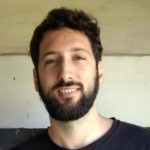Link to Pubmed [PMID] – 26140530
Link to DOI – 10.1038/ismej.2015.109
ISME J 2016 Feb; 10(2): 299-309
Arsenic metabolism is proposed to be an ancient mechanism in microbial life. Different bacteria and archaea use detoxification processes to grow under high arsenic concentration. Some of them are also able to use arsenic as a bioenergetic substrate in either anaerobic arsenate respiration or chemolithotrophic growth on arsenite. However, among the archaea, bioenergetic arsenic metabolism has only been found in the Crenarchaeota phylum. Here we report the discovery of haloarchaea (Euryarchaeota phylum) biofilms forming under the extreme environmental conditions such as high salinity, pH and arsenic concentration at 4589 m above sea level inside a volcano crater in Diamante Lake, Argentina. Metagenomic analyses revealed a surprisingly high abundance of genes used for arsenite oxidation (aioBA) and respiratory arsenate reduction (arrCBA) suggesting that these haloarchaea use arsenic compounds as bioenergetics substrates. We showed that several haloarchaea species, not only from this study, have all genes required for these bioenergetic processes. The phylogenetic analysis of aioA showed that haloarchaea sequences cluster in a novel and monophyletic group, suggesting that the origin of arsenic metabolism in haloarchaea is ancient. Our results also suggest that arsenite chemolithotrophy likely emerged within the archaeal lineage. Our results give a broad new perspective on the haloarchaea metabolism and shed light on the evolutionary history of arsenic bioenergetics.

